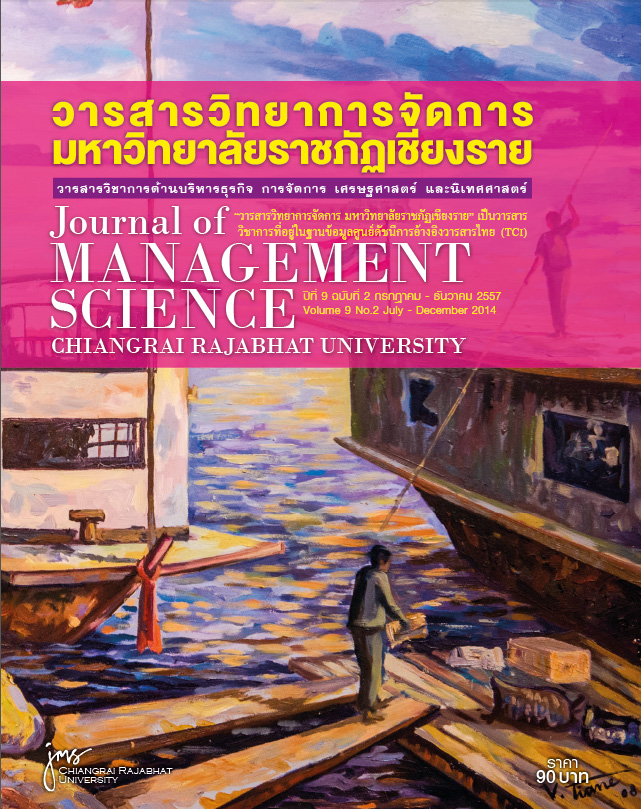Effect of Supply Chain Management Business Networking toward Operational Performance of Agricultural Marketing Cooperatives (AMCs) in Upper Northern Thailand.
Main Article Content
Abstract
The purpose of research was to study supply chain management, business networking, and operational performance, as well as to effect of supply chain management and business networking toward operational performance of agricultural marketing cooperatives (AMCs) in upper northern region of Thailand. A questionnaire approach was used as an instrument for data collection. A sample of 361 respondents included staffs and board committees of AMCs in upper northern region of Thailand. A survey research model was applied using descriptive statistical method to analyze data with percentage and standard deviation techniques. An inferential statistical analysis was performed for structural equation modeling (SEM) by PLS-Graph. The demographic data showed that the majority of respondents were male, aged between 31-40 years, having marital status, with education level of Bachelor’s degree, working at AMC branches in Chiang Mai. Most of them were committee members with their period of being less than 5 years of work experience, and their salaries were almost less than 15,000 baht. The respondents’ level of opinions reviewed that the supply chain management, business networks, and operational performance were at high levels in all areas. The structural equation modeling analysis indicated that the influence of supply chain management on business networks was at a highest level, and a minimal effect on operational performance.
Article Details
Views and opinions expressed in the journal do not necessarily reflect those of the editors.
References
Performance Indicators (KPIs), Economic Value Added (EVA) กับการประเมินผลการปฏิบัติงาน : กุญแจดอกสำคัญของการพัฒนามูลค่าเพิ่มขององค์การ. บุญฑวรรณ วิงวอน. (2555).การเป็นผู้ประกอบการ. กรุงเทพฯ: มหาวิทยาลัยรามคำแหง. บุญฑวรรณ วิงวอน, ชัยยุทธ เลิศพาชิน และขจรศักดิ์ วงศ์วิราช. (2554). การจัดการห่วงโซ่อุปทานของวิสาหกิจชุมชนกลุ่มผักปลอดสารพิษของ อำเภอห้างฉัตร จังหวัดลำปาง. การประชุมวิชาการและนำเสนอผลงานวิจัยระดับชาติ “แม่โจ้–แพร่ วิจัย ครั้งที่ 2”วันที่1-2กนยายน ั 2554. บุญฑวรรณวิงวอน และณัฐวดีพัฒนโพธิ์. (2556).
ภาวการณ์มุ่งเน้นการเป็นผู้ประกอบการ และผลการดำเนินงานของวิสาหกิจขนาดกลางและขนาดย่อม. วารสารสังคมศาสตร์วิชาการ, ปีที่6 ฉบับที่2เดือนกุมภาพันธ์-พฤษภาคม, หน้า123-146. ประหยัด จตุพรพิทักษ์กุล.(2548). เครือข่ายการเรียนรู้เกี่ยวกับระบบเกษตรกรรมกับทางเลือกของชุมชน. วิทยานิพนธ์ศึกษาศาสตร์มหาบัณฑิตมหาวิทยาลัยเชียงใหม่ วิทยา สุหฤทดำรง. (2545). การจัดการห่วงโซ่อุปทาน.กรุงเทพฯ: ซีเอ็ดยูเคชั่น. สหกรณ์การเกษตรเพื่อการตลาดลูกค้าธ.ก.ส.ลำปางจำกัด. (2557). รายงานประจำปี บัญชี 2557. ลำปาง :สหกรณ์การเกษตรเพื่อการตลาดลูกค้าธ.ก.ส.ลำปาง. ______. (2257). ประวัติสหกรณ์การเกษตรเพื่อการตลาดลูกค้า ธ.ก.ส. [Online]Available:http://www.sktbaacmarket.com/about/. [2557, มกราคม 16]. สหกรณ์การเกษตรเพื่อการตลาดลูกค้าธ.ก.ส. นครสวรรค์จำกัด. (2556). การก่อตั้งสหกรณ์การเกษตรเพื่อการตลาดลูกค้าธ.ก.ส. จำกัด. [Online]Available :http://amcnakhonsawan.com/NP-17892. [2557, มกราคม 16]. สามารถ มีเพียร. (2556).การดำเนินงานของ สกต. . สัมภาษณ์, วันที่ 26 มีนาคม 2556. สุรเมศวร์ พิริยะวัฒน์. (2554). โลจิสติกส์และห่วงโซ่อุปทาน. [Online]Available : http://
www.surames.com/images/column_1227454933/chapter%209%20introduction%20of%20logistics%20and%20supply%20chains.pdf. [2557,กุมภาพันธ์ 7]. Barnes, R. (1972). Learning System for the Future. Indiana : The Phi Delta Kappa Educational Foundation.
Christian, S. , & Alexander. (2012). Program Smart PLS Version: 2.0.M3. [Online] Available : http://www.smartpls.de. [2014,September 28]. Gibson,etal. (1997).“The Three-dimensional Coronal Magnetic Field during Whole Sun Month”. [Online] Available : http://www.bloggang.com/viewdiary.php?id=ajarnben&month=12-2010&date=16&group=24&gblog=1. [2013, December 23]. Handfield, R. B. , & Nichols, E. L. (2003). Supply Chain. [Online] Available :http://utcc2.utcc.ac.th/localuser/lrcappl/lrc/lrc_Howto_Detail. php?id=2008010005. [2014, January 20]. Kaplan, R. S., & Norton. D.P. (1992). Using the balance scorecard as a strategic Management system. Harvard Business Review,70(1): 71-79.


